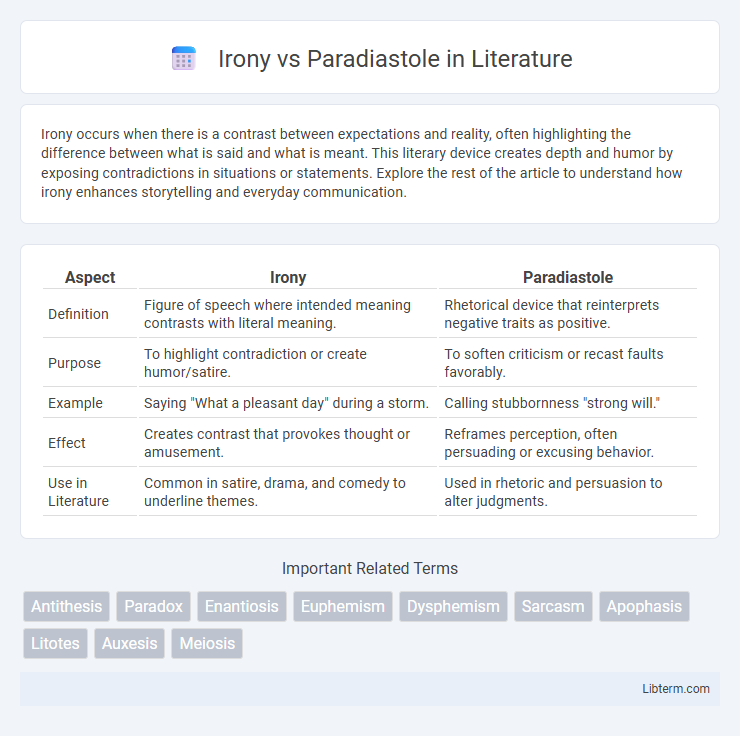Irony occurs when there is a contrast between expectations and reality, often highlighting the difference between what is said and what is meant. This literary device creates depth and humor by exposing contradictions in situations or statements. Explore the rest of the article to understand how irony enhances storytelling and everyday communication.
Table of Comparison
| Aspect | Irony | Paradiastole |
|---|---|---|
| Definition | Figure of speech where intended meaning contrasts with literal meaning. | Rhetorical device that reinterprets negative traits as positive. |
| Purpose | To highlight contradiction or create humor/satire. | To soften criticism or recast faults favorably. |
| Example | Saying "What a pleasant day" during a storm. | Calling stubbornness "strong will." |
| Effect | Creates contrast that provokes thought or amusement. | Reframes perception, often persuading or excusing behavior. |
| Use in Literature | Common in satire, drama, and comedy to underline themes. | Used in rhetoric and persuasion to alter judgments. |
Introduction to Irony and Paradiastole
Irony involves expressing meaning by using language that signifies the opposite, often to highlight discrepancies between appearance and reality or to create humor. Paradiastole, a rhetorical device, redefines or softens negative qualities by offering euphemistic or positive reinterpretations. Understanding irony and paradiastole is essential for grasping how language manipulates perception through contrast and redefinition.
Defining Irony: A Semantic Overview
Irony involves expressing a meaning opposite to the literal words, often highlighting contradictions between expectation and reality. Paradiastole, by contrast, softens negative traits through euphemistic redefinition to create a more favorable impression. Understanding irony semantically requires recognizing its reliance on contextual cues and pragmatic inversion, which distinguishes it from paradiastole's strategic reframing of character or action.
Paradiastole Explained: Meaning and Usage
Paradiastole is a rhetorical device that reframes a negative quality as a positive one by using euphemistic expressions, effectively altering the perception of an idea or behavior. It differs from irony, which typically conveys a meaning opposite to the literal words, often for humorous or emphatic effect. Paradiastole is commonly used in literature and speech to soften criticism, highlight virtues in flaws, or persuade audiences by morally redefining terms.
Historical Development of Irony and Paradiastole
Irony, traced back to ancient Greek literature and notably Sophocles and Socratic dialogues, evolved as a rhetorical device conveying meaning opposite to the literal words, primarily used for critique and humor. Paradiastole, emerging from classical rhetoric, served to reframe vices as virtues by employing euphemistic language to alter perception and soften moral judgment. The historical development of irony expanded through Renaissance playwrights like Shakespeare, while paradiastole maintained its role in persuasive speech and ethical reevaluation across philosophical and literary traditions.
Key Differences Between Irony and Paradiastole
Irony involves expressing meaning by using language that normally signifies the opposite, often to highlight contrast or humor, while paradiastole employs euphemistic redefinition to positively spin or soften a negative trait. Unlike irony's reliance on contradiction between literal and intended meaning, paradiastole focuses on reframing or mitigating unfavorable characteristics through selective wording. Understanding these distinctions clarifies how irony exposes disparity versus paradiastole's role in moral recharacterization or rhetorical persuasion.
Functions in Rhetoric and Literature
Irony functions in rhetoric and literature by expressing a meaning opposite to the literal interpretation, creating humor, criticism, or dramatic effect through contradiction and subtlety. Paradiastole, on the other hand, reframes negative traits as positive or neutral through euphemistic redefinition, often softening judgment and influencing perception. Both devices manipulate audience understanding, with irony highlighting disparity while paradiastole revises moral or emotional evaluation.
Examples of Irony in Contemporary Language
Irony often manifests in contemporary language through phrases like saying "Great weather!" during a storm, highlighting a stark contrast between expression and reality. Paradiastole, by comparison, euphemistically reframes negative attributes, such as calling "cheap" someone "thrifty" to soften judgment. Irony's prevalence in memes, social media posts, and everyday conversations underscores its role in humor and social critique.
Instances of Paradiastole in Texts
Instances of paradiastole in texts often appear as deliberate recharacterizations that soften negative traits, such as describing greed as ambition or stubbornness as perseverance. This rhetorical device contrasts with irony by emphasizing positive reinterpretations rather than highlighting contradictions between appearance and reality. Classic literature and political speeches frequently deploy paradiastole to evoke empathy or justify contentious actions through nuanced language.
Impact on Reader Interpretation
Irony creates a contrast between expectations and reality, often leading readers to question underlying meanings and perceive deeper societal critiques, which fosters a sense of skepticism or humor. Paradiastole, by reframing negative traits as positive or neutral, guides readers to reinterpret characters or situations in a more favorable light, influencing empathy and moral judgment. Both rhetorical devices manipulate reader interpretation but diverge in effect: irony provokes critical distance, while paradiastole promotes re-evaluation and acceptance.
Conclusion: Choosing Between Irony and Paradiastole
Choosing between irony and paradiastole depends on the desired rhetorical impact and audience perception. Irony often conveys criticism or humor through contrast between expectation and reality, highlighting hypocrisy or absurdity. Paradiastole, by reinterpreting negative traits as positive, softens judgment and reframes character, influencing tone and emotional response effectively.
Irony Infographic

 libterm.com
libterm.com